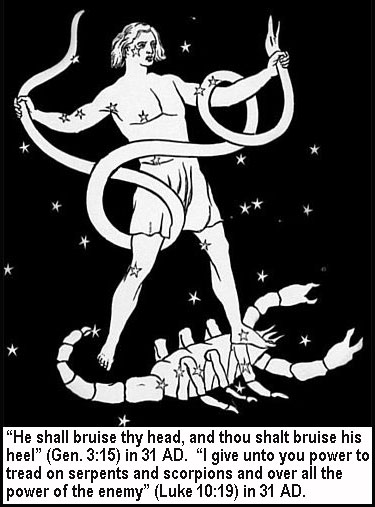.jpg)
Daniel's Amazing, Seventy-Weeks Prophecy
When was "the decree to restore and rebuild Jerusalem" (Dan. 9:25)? When was "Messiah ... cut off" (Dan. 9:26)? Who were the "people of the prince ... that shall destroy the city and the sanctuary" (Dan. 9:26)?
9:1 In the first year of Darius the son of Ahasuerus, of the seed of the Medes, which was made king over the realm of the Chaldeans;
2 In the first year of his reign I Daniel understood by books the number of the years, whereof the word of the Lord came to Jeremiah the prophet, that he would accomplish seventy years in the desolations of Jerusalem.
3 And I set my face unto the Lord God, to seek by prayer and supplications, with fasting, and sackcloth, and ashes:
4 And I prayed unto the Lord my God, and made my confession, and said, O Lord, the great and dreadful God, keeping the covenant and mercy to them that love him, and to them that keep his commandments;
5 We have sinned, and have committed iniquity, and have done wickedly, and have rebelled, even by departing from thy precepts and from thy judgments:
6 Neither have we hearkened unto thy servants the prophets, which spake in thy name to our kings, our princes, and our fathers, and to all the people of the land.
7 O Lord, righteousness belongeth unto thee, but unto us confusion of faces, as at this day; to the men of Judah, and to the inhabitants of Jerusalem, and unto all Israel, that are near, and that are far off, through all the countries whither thou hast driven them, because of their trespass that they have trespassed against thee.
8 O Lord, to us belongeth confusion of face, to our kings, to our princes, and to our fathers, because we have sinned against thee.
9 To the Lord our God belong mercies and forgivenesses, though we have rebelled against him;
10 Neither have we obeyed the voice of the Lord our God, to walk in his laws, which he set before us by his servants the prophets.
11 Yea, all Israel have transgressed thy law, even by departing, that they might not obey thy voice; therefore the curse is poured upon us, and the oath that is written in the law of Moses the servant of God, because we have sinned against him.
12 And he hath confirmed his words, which he spake against us, and against our judges that judged us, by bringing upon us a great evil: for under the whole heaven hath not been done as hath been done upon Jerusalem.
13 As it is written in the law of Moses, all this evil is come upon us: yet made we not our prayer before the Lord our God, that we might turn from our iniquities, and understand thy truth.
14 Therefore hath the Lord watched upon the evil, and brought it upon us: for the Lord our God is righteous in all his works which he doeth: for we obeyed not his voice.
15 And now, O Lord our God, that hast brought thy people forth out of the land of Egypt with a mighty hand, and hast gotten thee renown, as at this day; we have sinned, we have done wickedly.
16 O Lord, according to all thy righteousness, I beseech thee, let thine anger and thy fury be turned away from thy city Jerusalem, thy holy mountain: because for our sins, and for the iniquities of our fathers, Jerusalem and thy people are become a reproach to all that are about us.
17 Now therefore, O our God, hear the prayer of thy servant, and his supplications, and cause thy face to shine upon thy sanctuary that is desolate, for the Lord's sake.
18 O my God, incline thine ear, and hear; open thine eyes, and behold our desolations, and the city which is called by thy name: for we do not present our supplications before thee for our righteousnesses, but for thy great mercies.
19 O Lord, hear; O Lord, forgive; O Lord, hearken and do; defer not, for thine own sake, O my God: for thy city and thy people are called by thy name.
20 And whiles I was speaking, and praying, and confessing my sin and the sin of my people Israel, and presenting my supplication before the Lord my God for the holy mountain of my God;
21 Yea, whiles I was speaking in prayer, even the man Gabriel, whom I had seen in the vision at the beginning, being caused to fly swiftly, touched me about the time of the evening oblation.
22 And he informed me, and talked with me, and said, O Daniel, I am now come forth to give thee skill and understanding.
23 At the beginning of thy supplications the commandment came forth, and I am come to shew thee; for thou art greatly beloved: therefore understand the matter, and consider the vision.
24 Seventy weeks are determined upon thy people and upon thy holy city, to finish the transgression, and to make an end of sins, and to make reconciliation for iniquity, and to bring in everlasting righteousness, and to seal up the vision and prophecy, and to anoint the most Holy.
25 Know therefore and understand, that from the going forth of the commandment to restore and to build Jerusalem unto the Messiah the Prince shall be seven weeks, and threescore and two weeks: the street shall be built again, and the wall, even in troublous times.
26 And after threescore and two weeks shall Messiah be cut off, but not for himself: and the people of the prince that shall come shall destroy the city and the sanctuary; and the end thereof shall be with a flood, and unto the end of the war desolations are determined.
27 And he shall confirm the covenant with many for one week: and in the midst of the week he shall cause the sacrifice and the oblation to cease, and for the overspreading of abominations he shall make it desolate, even until the consummation, and that determined shall be poured upon the desolate.
Daniel 9:24 -27 says, "Seventy weeks (or 490 years) are determined upon thy people (the Jews) and upon thy holy city (Jerusalem), to finish the transgression, and to make an end of sins, and to make reconciliation for iniquity, and to bring in everlasting righteousness, and to seal up (or end) the vision and the prophecy (or prophet), and to anoint the most Holy. Know therefore and understand, that from the going forth of the commandment to restore and to build Jerusalem unto the Messiah the Prince shall be seven weeks, and threescore and two weeks (69 weeks or 483 years): the street shall be built again, and the wall, even in troublous times. And after threescore and two weeks shall Messiah be cut off, but not for his own sins; and the people of the prince that shall come shall destroy the city and the temple, and the end of it shall be with a flood (or army), and unto the end of the war desolations are determined. And he shall confirm the covenant with many (Jews) for one week (7 years): and in the midst of the week shall he cause the sacrifice and offering to cease, and for the overspreading of abominations he shall make it desolate, even until the consummation, and that determined shall be poured upon the desolator."
1.) How did transgressions finish and sins end? As Jesus was dying, he cried: "It is FINISHED." (John 19:30) "He was wounded for our TRANSGRESSIONS" (Isaiah 53:5; Heb. 9:15). He came "to save his people from their sins", and accomplished this when he "put away sin by the sacrifice of himself" (Mt. 1:21; Heb. 9:26). "It is not possible that the blood of bulls and of goats should take away sins... But this man, after he had offered one sacrifice for sins for ever...hath perfected for ever them that are sanctified...And their sins... remember no more" (Heb. 10:4-11). John announced him as "the Lamb of God, which taketh away the sins of the world" (John 1:29). "Christ died for our sins" (1 Cor. 15:3). He "bare our sins in his own body on the tree" (l Peter 2:24) and "hath once suffered for sins" (3:18). "He was manifested to take away our sins" (l John 3:5).
2.) How was "reconciliation for iniquity" accomplished? Once again, Jesus, "our merciful and faithful high priest" made "RECONCILIATION for the sins of the people" (Heb. 2:17). "Having made peace through the blood...to RECONCILE all things unto himself...and you, that were sometimes alienated...hath he RECONCILED...through death" (Col. 1:20-22; Eph. 2:16)."God was in Christ, RECONCILING the world unto himself, not imputing their trespasses unto them; and hath committed unto us the word of RECONCILIATION" (2 Cor. 5:19). He "gave himself for us, that he might redeem us from all INIQUITY" (Titus 2:14), and "the Lord hath laid on him the INIQUITY of us all" (Isaiah 53:6).
3.) Did Jesus "bring in everlasting righteousness"? "My righteous servant shall make many RIGHTEOUS" (Isa. 53:11). Paul said, "By the righteousness of one...shall many be made RIGHTEOUS... unto eternal life by Jesus Christ" (Rom. 5:17-21). He who came "to fulfill all righteousness'' (Mt. 3:15) and who "loved righteousness, and hated iniquity", was "anointed" of God (Heb. 1:9) and made unto us wisdom, and RIGHTEOUSNESS, and sanctification, and redemption" (1 Cor. 1:30). "Who his own self bare our sins in his own body on the tree, that we, being dead to sins, should live unto RIGHTEOUSNESS" (1 Peter 2:24). "Even the RIGHTEOUSNESS of God...through the redemption that is in Christ Jesus: whom God hath set forth to be a propitiation through faith in his blood to declare his RIGHTEOUSNESS for the remission of sins" (Rom. 3:21-26). "For he hath made him to be sin for us, who knew no sin; that we might be made the RIGHTEOUSNESS of God in him" (2 Cor. 5:21). "Everyone that doeth RIGHTEOUSNESS is born of him" (1 John 2:29). "By his own blood he entered in once into the holy place, having obtained ETERNAL REDEMPTION "—everlasting righteousness—" for us" (Heb. 9:12).
4.) How did Jesus "seal up vision and prophecy", or literally, "seal up vision and prophet"? The use of the metaphor "to seal" is derived from the ancient custom of attaching a seal to a document to show that it was genuine (See 1 Kings 21:8; Jer. 32:10, 11; cf. John 6:27; 1 Cor. 9:2). Christ "sealed" Old Testament prophecy by fulfilling what was written of him. Repeatedly we read concerning him: "...that it might be fulfilled which was spoken by the prophets." Acts 3:18 says: "Those things which God before had shewed by the mouth of all his prophets, that Christ should suffer he hath so fulfilled:" Truly Jesus fulfilled what was written in the visions and prophecies of the Old Testament concerning him, and thus he "sealed" them—showed that they were genuine. As he said, 'They are they which testify of me" (John 5:39). "All the prophets and the law prophesied until John" (Mt. 11:13), then John presented Jesus as he that was to be "made manifest to Israel."
5.) How did he "confirm the covenant"? When Jesus instituted the Lord' s supper, representative of his shed blood for the remission of sins, he said: 'This is my blood of the new testament [covenant], which is shed for many for the remission of sins" (Mt. 26:28). The word "testament" here and the word "covenant" are translated from exactly the same word in the New Testament. "How much more shall the blood of Christ...purge your conscience from dead works to serve the living God? And for this cause he is the mediator of the new testament [covenant]" (Heb.9:14,15). Jesus is called the "mediator of the new covenant" (Heb. 8:6), the "messenger of the covenant" (Mal. 3:1), and his shed blood is called "the blood of the everlasting covenant" (Heb. 12:24). Our Lord Jesus is the one who confirmed the covenant through his redemptive sacrifice at Calvary. And how beautifully this harmonizes with what we have already seen.
6.) Which decree started the "Seventy Weeks" count?
The temple and city of Jerusalem were destroyed in 586 B.C. by Babylonians (2 Ki. 24:17-25:21). Then for seventy years Jerusalem was desolate (Jer. 25:11) from 609 B.C. when the Egyptians were defeated by Nabopolaser till Cyrus destroyed Babylon in 539 B.C. and from 586 B.C. when the Temple was destroyed till 515 B.C. when it was completely rebuilt.
Then there were FOUR decrees to rebuild the Temple and Jerusalem. They are mentioned in Ezra 6:14 "And they builded, and finished it ... according to the commandment of Cyrus, and Darius, and Artaxerxes king of Persia" (who gave two decrees). The question is which decree of which Persian king fulfills the prophecy? Cyrus issued the FIRST decree for the TEMPLE to be rebuilt (2 Chr. 36:23 in 539 B.C.). The altar was set up (Ezra 3:3) and the TEMPLE foundations were laid out (Ezra 3:8-11). But the building project was annulled by Cambyses in 536 B.C. (in Ezra 4:21, Artaxerxes or Ahasuerus) thus fulfilling a prophecy of Isaiah 44:28 (c.710 B.C.) that only the foundations of the TEMPLE should be laid at this time (Ezra 3:10): "Who saith of Cyrus, He is my shepherd, and shall perform all my pleasure; even saying to Jerusalem, Thou shalt be built; and to the TEMPLE, Thy foundation shall be laid." Darius then issued a SECOND decree to advance the building of the TEMPLE (Ezra 4:24 to 6:1-12 in 520 B.C.), which was completed in the sixth year of his reign (515 B.C.) (Ezra 6:15). Therefore the decrees of Cyrus and Darius concerned the TEMPLE. But the city of Jerusalem still remained ruinous.
Then Artaxerxes Longimanus gave the THIRD decree in 457 B.C. "to set up the house of our God, and to repair the desolations thereof, and to give us a WALL in Judah and in JERUSALEM" (Ezra 7:11;9:9). Ezra 7:6-9 shows that the decree went out in the seventh year of the reign of Artaxerxes. Next we come to the FOURTH decree which Artaxerxes made in 445-4 B.C. and this decree involving Nehemiah specifically mentions rebuilding the WALLS of JERUSALEM (Neh. 2) in the 20th year of Artaxerxes' reign. See the Astronomical Canon of Ptolemy (Almagest) to confirm these dates. The years of Persian kings' reigns started in the autumn or September.
Incidentally, 2,300 LUNAR years from 444 B.C. gives 1789 A.D. (when French Revolution commenced) and 2,300 SOLAR years from 457 B.C. gives 1844 A.D. (when Turkey abolished execution for apostasy. This was also when the Sultan of Turkey granted permission to erect on Mount Zion the first English Church.). These two measurements cross one another at the central solar-lunar date of 29-30 A.D.
7.) What happened after the first 49 years?
This prophecy is split into three sections. Seven weeks (49 years, which is the time it took to rebuild JERUSALEM), 62 weeks (434 years) till Messiah the Prince which takes us to the year A.D. 27, the year that Jesus was "anointed" and began His ministry in the autumn, and finally there is another week of 7 years. If the midst of this seven year period is Passover (March-April) when he died, then the beginning of this seven-year period was in the autumn (July-August).
The first seven weeks or 49 years on the solar scale from 457 B.C. bring us to 408 B.C. which witnessed the rebuilding of JERUSALEM, its walls and streets (Neh. 6:15,16; 7:4). The last act of Nehemiah occurred in the fifteenth year of of the reign of Darius Nothus which was the year 408 B.C., exactly 49 years from 457 B.C. Barnes and several other trustworthy Bible commentators mention the historian Prideaux who declared Nehemiah's last action in rebuilding the CITY occurred in the 15th year of the Persian ruler Darius Nothus (423 - 404 B.C.). Josephus seems to support this idea in his remarks about the death of Nehemiah. The solar 49 year period witnessed the rebuilding of JERUSALEM in "troublous times" (Ezra 4:4-5 and Nehemiah 4 & 6).
8.) Did Messiah the Prince come after "Sixty-Nine Weeks" (or 483 years)?
Ezra left Babylon with his royal decree on the 1st of Nisan (March-April) and reached Jerusalem four months later on the 1st of Ab (July-August) in 457 B.C. (Ezra 7:9). Nehemiah received his royal decree in Nisan (March-April) of 444 B.C. and we assume he also took four months to arrive at Jerusalem. Both decrees actually took effect in July-August of 457 or July-August of 444 B.C.
In Bible prophecy we use the day for a year system. Ezekiel 4:6 says, “...I have appointed thee each day for a year” (cp. Num. 14:34) so that 70 weeks or 490 days becomes 490 years. The first calculation is SOLAR years using 365.25 days while the second is LUNAR years using 354.33 days. A third calculation uses PROPHETIC years of 360 days each. "At the mouth of two witnesses, or at the mouth of three witnesses, shall the matter be established" (Deut. 19:15). Two or three witnesses are required to prove any point according the Bible. The LUNAR year is 10.876 days short of the SOLAR year so an extra month was added to the LUNAR calendar about every three years to keep the seasons from moving through the LUNAR year. This meant some years contained thirteen months.
"Know therefore and understand, that from the going forth of the commandment to restore and to build Jerusalem unto the Messiah the Prince shall be seven weeks, and threescore and two weeks (483 years)" (Dan. 9:25).
Adding 483 SOLAR years to 457 B.C. brings us to the first of July-August, 27 A.D. which was the beginning of Christ's public ministry and his baptism. Adding 490 SOLAR years to 457 B.C. brings us to the martyrdom of Stephen in 34 A.D. Adding 483 LUNAR years to 444 B.C. brings us to February-March 2nd, 26 A.D. (Because 483 LUNAR years are equivalent to 469 SOLAR years: 365.2422 days - 354.366 days = 10.8762 days difference x 483 years = 5253.2046 days / 365.2422 = 14.38 SOLAR years difference.), the year of John the Baptist's preparatory ministry, when he revealed the Messiah at his baptism. Adding 483 PROPHETIC years to 444 B.C. brings us to 33 A.D. (because 483 PROPHETIC years are equivalent to 476.07 SOLAR years: 483 x 360 = 173880 days /365.24 = 476.07) which was the last year of Stephen's witness to the Jews before his martyrdom. Messiah was crucified in A.D. 31. Most scholars have tried to place the crucifixion in either 30 or 33 A.D. because these are the only two years in the time frame of Jesus' death when Passover fell on Friday. In the year 31 A.D. Passover fell on Wednesday -- the "midst" of a literal "week" as well as the midst of a seven-year Sabbatic period. According to the translator of Josephus, the Jewish new year that began in the fall of 27 A.D. marked the beginning of the last Jubilee Year that the Jews enjoyed in the land before their worldwide dispersal by the Romans in 70 A.D. This is most likely the year that Jesus began His public ministry. This is hinted at in Luke 4 where it says that when Jesus launched His ministry at the synagogue in Nazareth, He did so by reading a passage from Isaiah 61 about the way in which the Messiah would fulfill the spiritual essence of the Jubilee. After finishing the reading, Jesus proclaimed, "Today this Scripture has been fulfilled in your hearing" (Luke 4:21).
Remember that a mathematical error of one year is accounted for by the fact that 1 B.C. and 1 A.D. are both part of the same year. To be even more precise, Jesus "being about 30 years of age" at his baptism by John in the Jordan (Luke 3:23) must have been born about 4 B.C. because 27 A.D. - 30 = 4 B.C. When Christ was born, Herod the Great was still alive, and Herod died in 4 B.C. (see Matt. 2:13-20). Jesus may have been born on the Festival of Sukkot -- fifteenth day of the seventh month. Herod died about 6 months later just before Passover (Ant. 17:8:1; Wars 1:33:8). "The fifteenth year of the reign of Tiberius" (Luke 3:1) can be independently established as 26-27 A.D., because Tiberius' reign began two years before the death of Augustus -- 12 A.D., and it was at the Passover of 28 A.D. that the Jews said to Christ, "Forty and six years was this temple being built " (John 2:20) and it was also Herod's eighteenth year (Ant. 15:11) which can be independently established. "When the fulness of the time was come, God sent forth His Son" (Gal. 4:4) and Jesus preached that "the time was fulfilled" (Mark 1:15), both scriptures referring to the "sixty-nine weeks" unto Messiah. Also, if the SOLAR reckoning provides the beginning of his public ministry, perhaps the LUNAR reckoning provides the date of his private return to Palestine (Matt. 25:19). He died on Wednesday, 14th day of the first month Nisan, 31 A.D. as the Passover lambs were being slain in the temple (Wars 6:9:3).
Daniel 9:26 says that in the midst of the final seven years the Messiah will be "cut off, ("He was cut off out of the land of the living" -- Isa. 53:8) but not for himself." "He was wounded for our transgressions" (Isa. 53:5) (showing that Jesus would die after 3 1/2 years of ministry) and "in the midst of the week He shall cause the sacrifice and the offering to cease." On the tenth of Nisan our Lord fulfilled Zechariah 9:9 "thy King cometh unto thee; he is just, and having salvation; lowly, and riding upon an ass." This is recorded in Luke 19:38 when his disciples sang Psalm 118: "Blessed be the King who cometh in the name of the Lord." But they were accused of blaspheming because the Pharisees "knewest not the time of thy visitation" (Luke 19:44) -- the sixty-nine weeks plus half a week more.
"A certain NOBLEMAN (Jesus) went into a FAR COUNTRY (Britain) to receive for himself a kingdom, and to RETURN (to Palestine after 18 years). And he called his TEN SERVANTS (lost ten tribes in Britain, Parthia, Scythia, Greece, etc.), and delivered them ten pounds, and said unto them, Occupy (my kingdom) till I come. But his CITIZENS (the Shammai Jews) hated him, and sent a message after him, saying, We will not have this man to reign over us" (Luke 19:12-14). When he returned, his ministry which began in the autumn of 27 A.D. lasted for exactly three-and-one-half years (Luke 13:32-33). That is why He could confidently say, "My time is not yet fully come" (John 7:8) prior to the midst of the week, Passover in the spring of 31 A.D.. Jesus' one time perfect sacrifice offered up by the murderous "priests" of Judah put an end to the penalty of sin which is the death of mankind and the need for animal sacrifices once and for all.
Daniel 9:27 says, "And he shall confirm the covenant with many (i.e. Jews) for one week: and in the midst of the week shall he cause the sacrifice and offering to cease."
According to Josephus (37-100 A.D.), Tacitus (55-120 A.D.) and Suetonius (69-130 A.D.), Jews were expecting the fulfillment of a prophecy of a ruler to arise in the first century A.D. from Daniel's prophecy. During this 70th week, the gospel was preached only to Israel (Acts 11:19). "Jesus Christ was a minister of the circumcision for the truth of God, to confirm the promises made unto the fathers" (Rom. 15:8). What happened in the final 3 1/2 years of this prophecy? The gospel message was still preached exclusively to the Jews (Acts 2), but at the end of this period in 34 A.D. , Stephen was stoned, marking the final decision of the Jewish leaders to reject Christ as the Messiah and from this time on the New Covenant was taken to gentile Israel. (cp. Rom. 15:8). Saul was present at the stoning of Stephen (Acts 7:58) and he later became Paul, the apostle to Gentile Israel. This shows us that the martyrdom of Stephen terminated the New Covenant to Jews and began the New Covenant to Gentile Israel. In Acts 9 Saul becomes the apostle to the Gentile Israel. In Acts 10 the gospel is given to the gentile house of Cornelius. (See also Acts 10:45, 11:18, 13:46, 14:27, 15:9, 18:6). In the parable of Luke 20:9 the original husbandmen (the Jews) of the vineyard are rejected and replaced. The "vineyard" was "let out ... unto other husbandmen" (Matt. 21:41; Isa. 5:1-7). "The kingdom of God shall be taken from you (Jews of Palestine who reject me as Messiah), and given to a nation (Christians of Britain) bringing forth the fruits of it" (Matt. 21:43).
9.) What happened in 34 A.D.?
After his resurrection, Jesus continued to work through his disciples on the day of Pentecost and after. They continued to confirm the covenant with "many (JEWS) for one week." He came "unto his own," (John1:11), which was the JEWS, for Jesus was of the tribe of JUDAH (Heb 7:14; Rev 5:5). So the last half of the covenant being confirmed was Jesus working with the JEWS, "for salvation is of the JEWS" (John 4:22), and Paul also said, "salvation to every one that believeth; to the JEW first (for 490 years), and also to the GREEK" (second for at least 280 years) (Rom 1:16). The crucifixion occurred 3 1/2 years after the baptism of Jesus in September/October in 27 A.D. bringing us to the spring of 31 A.D. So the end of Daniel's 70th week must be in the fall of 34 A.D. According to Daniel 9:24, this vision was to come to an end by the death of a "prophet." Young's Literal Translation says, "to seal up (to end or complete the) vision and prophet." A prophet's life was to end when this vision ended -- at the end of the 490 year period. (See 70 Weeks, Leviticus, Frank B. Holbrook, p.80). Who was this prophet? The stoning of Stephen occurred in 34 A.D. (Acts 6:12 to 7:60). He was the last prophet to speak to the JEWISH people of JUDEA as the elect of God. When he was rejected and stoned to death, the 'vision' and 'prophet' both ended. Soon after, Paul was called to be an apostle to the "gentiles" (ISRAEL) (Acts 9), and Peter was told that "gentiles" (ISRAEL) should be accepted into church fellowship (Acts 10). The seventy weeks probation for JEWS to accept the Messiah and enter into the New Covenant failed, and so Jesus said to them, "The stone (Jesus the Messiah) which the builders (JEWS) rejected, the same is become the head of the corner ... The kingdom of God shall be taken from you (JEWS), and given to a nation bringing forth the fruits thereof." (Matthew 21:42-43). Christian ISRAELITES who migrated to Britain. Notice, the New Covenant is with the "house of ISRAEL, AND with the house of JUDAH" (Jer. 31:31). It was to the "JEW FIRST, and also to the GREEK." (Rom 1:16). The gospel in the 490 years was only for the house of JUDAH. Notice Daniel 9:24 again, "Seventy weeks are determined upon THY people." Daniel was of the house of JUDAH, not the house of ISRAEL which was lost in history. The context is JUDAH'S 70-year captivity in Babylon and the remnant of JUDAH that returned -- not ISRAEL -- the lost ten tribes. Jesus said, "I am not sent but unto the lost sheep of the house of ISRAEL" (Matthew 15:24). And he commanded the apostles to, "Go NOT into the way of the Gentiles, and into any city of the Samaritans enter ye not ... But go rather to the lost sheep of the house of ISRAEL" (Matt 10:5-6).
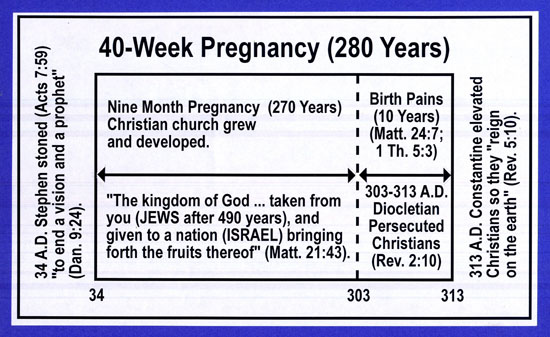
That last week ended in 34 A.D. with the gospel being preached to the Gentiles. If we add a nine-month PREGNANCY (270 years) to 34 A.D., we come to the "BIRTH PANGS" of 303-313 A.D. when Diocletian persecuted Christians prior to the coming of Constantine (Christ) when their BIRTH figuratively occurred. "These things are the beginning of travail" (Matt. 24:7-8). These things are a type of the plan just before the real second coming of Christ.Then come the birth pains "as travail upon a woman with child" (1 Th. 5:3) beginning the LABOR contractions: war, famine, disease, earthquakes (Matt. 24:8; Isa. 13:8). The Israelite must be "born again" (John 3:3), not composed of flesh but composed of spirit this time (John 3:6). Jesus was the "firstborn among many brethren" (Rom. 8:29).
10.) What happened in 70 A.D.?
The last week of seven years of Daniel 9:26-27 has two fulfillments. Verse 26 says, “the people of the prince that shall come shall destroy the city and the sanctuary, and the end of it shall be with a flood (army).”
From 27 to 34 A.D. God the Father and King confirmed the Old Covenant exclusively to the Jews for seven years and in the midst of the seven years, the unbelieving Jew of Pharez Judah -- the same tribe as Messiah His Princely Son -- caused the sacrifices to cease (31 A.D.) (see Dan. 9:26-27) by destroying his human temple of flesh (John 2:19) against the wishes of Christ (Matt. 26:39) because Christ was a perfect righteous sacrifice. Jesus said, "Destroy this temple, and in three days I will raise it up ... But he spoke of the temple of his body" (John 2:19,21). Then from 67 to 73 A.D., Emperor Vespasian the father and king waged a war with the Jews for seven years and in the midst of the seven years the Roman army of Titus his princely son caused the sacrifices and offerings to cease (70 A.D.) (see Daniel 9:26-27) by destroying the beautiful stone Temple even against the wishes of Titus (Josephus, Wars 6:2; 5:12) because the gold had melted between the cracks. Thus "There shall not be ... one stone (left) upon another" (Matt. 24:2) by this army "flood" (Dan. 9:26). From Jerusalem in 67 A.D. till Masada in 73 A.D., the war with Rome continued seven years until the Jewish revolt was crushed.
God gave the Jews a generation of 40 years to repent from A.D. 26-27 to 66-67, 31 A.D. to 70 A.D. and 34 to 73 A.D. Herod's Temple was destroyed on 9 Av (August 4, 70 CE on the Julian calendar) by the Romans. The Babylonian Talmud records that for 40 years before the Temple was destroyed, the following events occurred: The lots for the Yom Kippur goats ceased to be supernaturally determined; the crimson thread tied to the Azazel goat's horn (which had before supernaturally turned white to show God's forgiveness) remained red; the western candle in the menorah in the Temple sanctuary would not burn continually; and the doors of the Temple would open by themselves (Yoma 39b). The gospel was preached to every man and woman of Judah in all the earth (Rom. 10:18). In the last week of September and in the first week of October of 66-67 A.D., the Roman army under Cestius reached and surrounded Jerusalem exactly 40 years from the time Jesus public ministry had begun in Judea in 27 A.D. "Forty years long was I grieved with this generation" (Ps. 95:10; cp. Heb. 3:30). Soon there was fighting about the temple itself. The Romans "attempted to break into the temple at the northern quarter of it; but the Jews beat them off from the cloisters." The cloisters were parts of the temple buildings. The Roman soldiers then placed their shields together in "tortoise-back" formation to protect themselves from darts shot from the wall above and"undermined the wall and got all things ready for setting fire to the gate of the temple" (Josephus' Wars). Jesus had warned his disciples, "When ye therefore shall see the abomination of desolation, spoken of by Daniel the prophet, stand in the holy place ... then let them which be in Judea flee into the mountains: let him which is on the housetop not come down to take anything out of his house: neither let him which is in the field return back to take his clothes.... But pray ye that your flight be not in the winter, neither on the Sabbath day" (Matt. 24:15-20). Roman standards around the temple itself were a signal to Christians to flee. Those in the fields or villages round about could easily do so; but how could those in the city escape, with the Roman army encompassing the walls? Josephus says that just as Cestius had the wall undermined and all in readiness for the attack, suddenly "he recalled his soldiers from the place, and by despairing of any expectation of taking it, without having received any disgrace, he retired from the city, without any reason in the world" (Wars 2:19). As the Jews rushed out to attack the retreating Romans, the brief moment and the opportunity for the flight of the Christians had come. Though the next siege was deferred four years ("midst of the week"), the time for flight was that day when the Jewish forces rushed from the city. As the fanatical Zealots came back exulting from slaying the rearguard of Cestius's army, they came to take possession of affairs in Jerusalem, and to organize every force for the next attack. Christian believers attempting to get away then would have met no mercy. The Zealots created and maintained a "reign of terror."
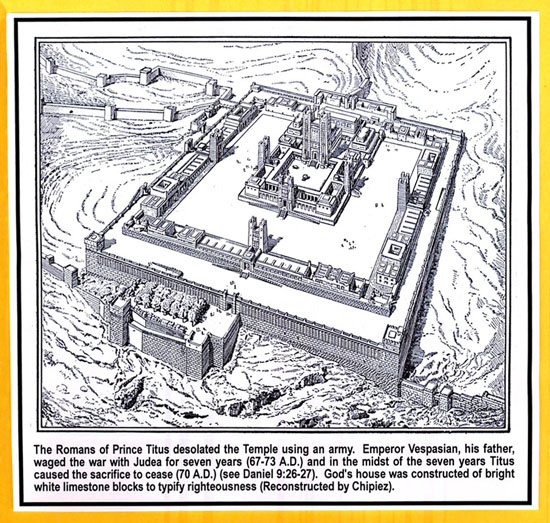
Christians escaped into the mountains across the Jordan, as they had been forewarned by Jesus to "flee" when they saw Jerusalem compassed with armies. For four years the war flowed over Judea. At the time of the Passover, A.D. 70, the Roman Prince Titus, son of Vespasian the Emperor, reached Jerusalem with his army and immediately proceeded to lay siege to the city. This was 40 years to the day from the time the Jews crucified Jesus. Within a month the Romans had built their siege works completely around Jerusalem so that none could escape. In June the assault began and on August 4th, A.D. 70, the Romans captured the lower city and set fire to the temple. At the end of August the rest of the city was captured and set on fire. Titus tried to persuade the Jewish leaders to save the temple by saying, "I do not force you to defile this your sanctuary; and if you will but change the place wherein you will fight, no Roman shall either come near your sanctuary nor offer any affront to it; nay, I will endeavor to preserve you your holy house whether you will or not" (Wars 6:2). Later Titus "called God to witness that this (temple destruction) was not his doing" (Wars 5:12). After the city fell, and Titus had examined the walls and towers, he exclaimed, "We have certainly had God for our assistant in this war and it was no other than God who ejected the Jews out of these fortifications" (Wars 6:9). When Christ foretold the coming destruction, even his disciples exclaimed about these same fortifications, "Master, see what manner of stones and what building are here!"
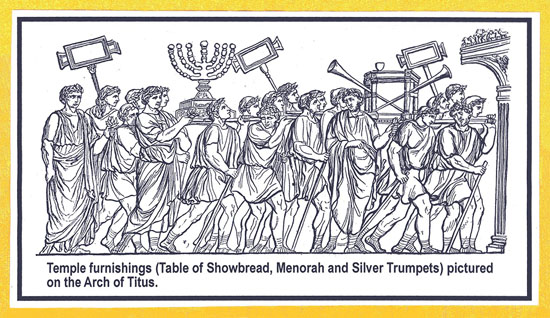
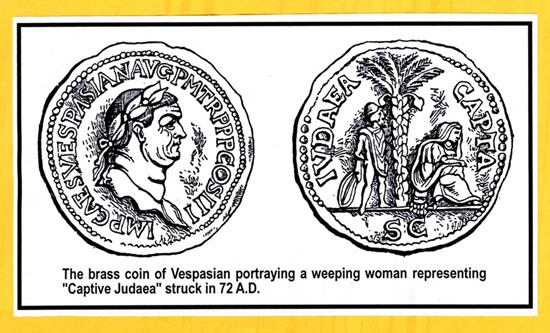
Over 1,100,000 of Judah perished by famine, disease and the sword of the Romans (Josephus' Wars 6:9:3). The destruction of both the first and the second temple were a result of the people’s rejection and disobedience to God. Jesus had warned the Jews before his death that because they rejected him as Messiah, the Kingdom of God would be taken from them and given to another nation bringing forth fruits of obedience (Matt. 21:23), that because the Jews had killed his son and his servants (the apostles), God would send forth his armies to destroy their nation and burn their city (Matt. 22:1-8) and "your house is left unto you desolate" (Matt. 23:28) and "not one stone would be left standing upon another" (Matt. 24:2). Jesus then defined what the "abomination of desolation" standing "in the holy place" was in Luke 21:20: "When ye shall see Jerusalem compassed with armies, then know that the desolation thereof is nigh" referring back to Daniel 9:26-27 and the army "flood" and "war" that desolates. The Jews had rejected God's hen wings of protection (Matt. 23:27) and so now accepted Rome's eagle wings of destruction (Dan. 9:27). The gold eagle standard and red serpent standard were objects of worship among the soldiers. The emperor's image was also carried and worshipped by the soldiers. Roman legions carried their standards, the EAGLE and the SERPENT (both unclean), into the Temple and sacrificed before them in the traditional Roman manner -- an ox, a sheep, and a PIG (unclean) -- hence "ABOMINATION of desolation." Just as Jews of their prince Messiah destroyed his fleshly temple (John 2:19), so the Roman army of Titus the prince leveled the stone temple to the ground because the gold had melted between the cracks. Thus "There shall not be ... one stone (left) upon another" (Matt. 24:2) by this army "flood" (Dan. 9:26). From Jerusalem in 67 A.D. till Masada in 73 A.D. the war with Rome continued until the Jewish revolt was crushed.
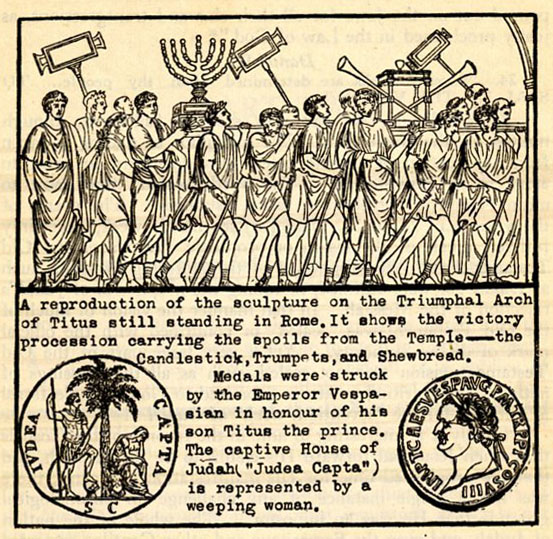
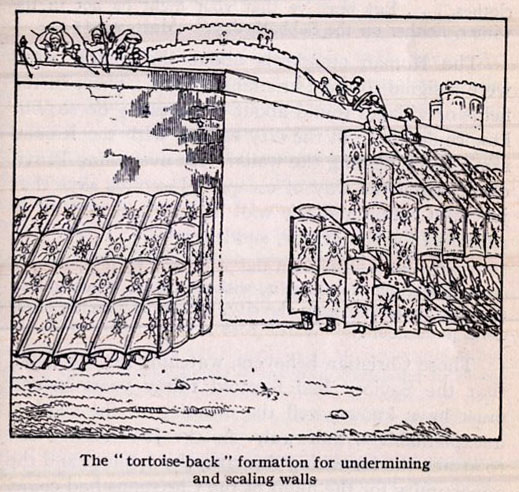
This event signified that the sacred appointment of the Jewish people as God’s chosen ones was forever annulled. Through Christ a new covenant was made, that all who followed Him would be called the children of God and seed of Abraham. Galations 3:29 “And if ye be Christ's, then are ye Abraham's seed, and heirs according to the promise.”
11.) Another interpretation of Daniel's 70-Weeks Prophecy:
If the 70 Weeks end when God "brings in everlasting righteousness" (Dan. 9:24), then we believe this must refer to the Second Coming of Our Messiah as well as His First Coming. There were 70 literal years of captivity for Daniel and the other Jews to end captivity in physical Babylon (605 to 537 B.C.). Near the end of that 70 years he received the 70-Weeks vision. There were 70 Sabbatical Years (70 x 7 = 490 years) till Messiah's first coming to end spiritual captivity in spiritual Babylon (457 B.C. to 34 A.D.). We believe there will also be 70 Jubilees (70 x 49 =3430 years) or 3430 years till Messiah's Second Coming to more fully end spiritual captivity in spiritual Babylon (1405 B.C. to 2026 A.D.). Israelites were instructed on how to observe the Jubilee just prior to entering Canaan. Therefore, we begin our count the year they entered Canaan -- 1405 B.C. If we add 3430 years to this date we get 2026 A.D. “Then Peter came to Him and said, ‘Lord, how often shall my brother sin against me, and I forgive him? Up to seven times?’ Jesus said to him, ‘I do not say to you, up to seven times, but up to seventy times seven.’” Matthew 18:21,22. Then our Messiah will return to "bring in everlasting righteousness" (Dan. 9:24).
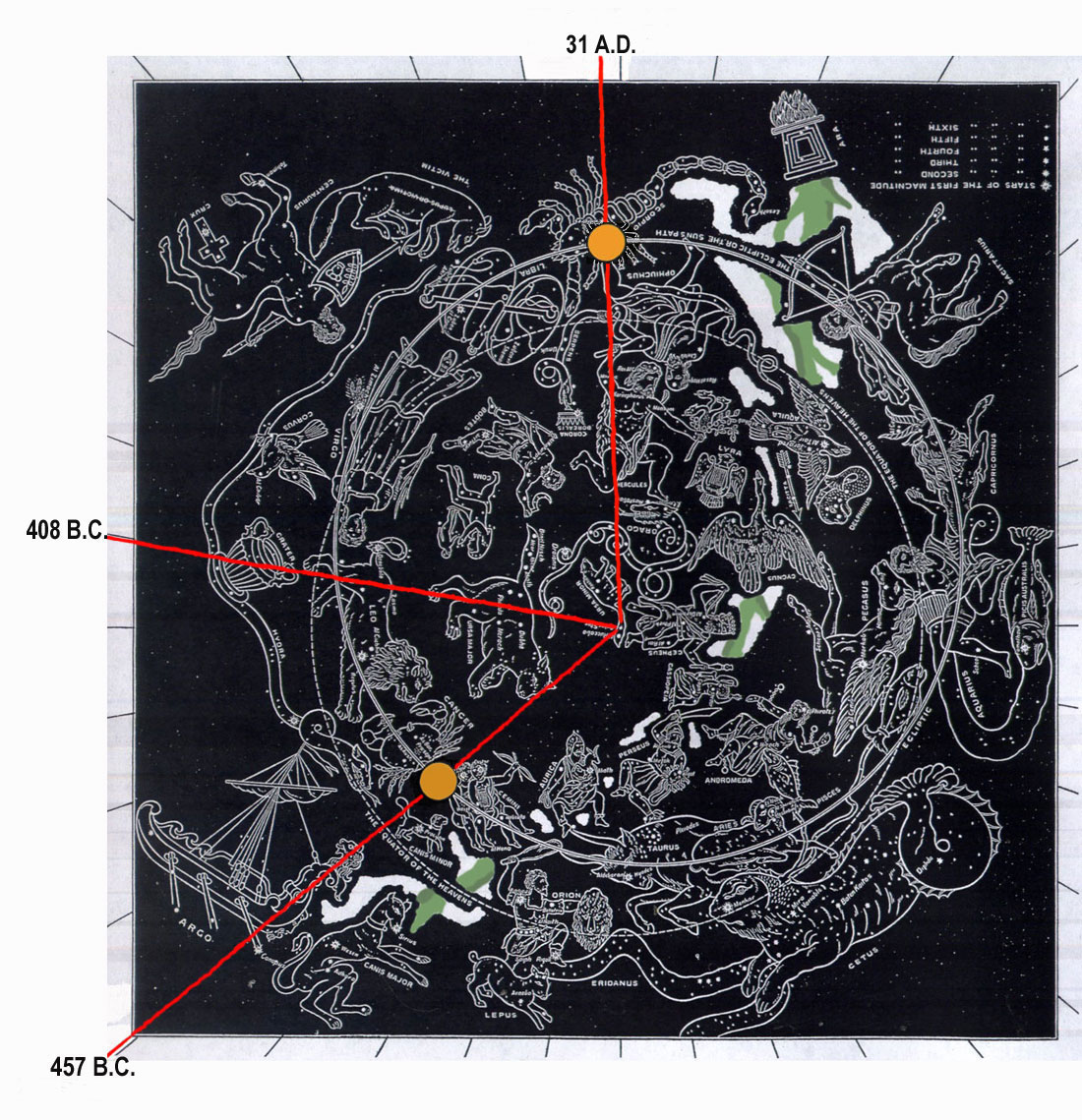
Daniel Chapter 9 Star Chart: Clockwise "from the (red radius line) going forth of the commandment to restore and to build Jerusalem" (9:25) in 457 B.C. (golden sun words out of Gemini's mouth) to when the "Messiah (shall) be cut off (by a red radius line spear), but not for his own sins" (9:26) and "cause the sacrifice and offering to cease" (9:27) by his sacrifice in 31 A.D. (Ophiuchus' heel sun-bruised by Scorpio -- Gen. 3:15), is one lap around (360°) plus 126.5° since it is "in the midst of the (70th) week" (9:27) counting from 457 B.C. (457 B.C. + 490 years = 34 A.D. - 3 1/2 years = 31 A.D.) bringing us to 31 A.D. In the year 539 B.C. (Dan. 9:1), Daniel studied Jeremiah 25:10 which says "these nations shall serve the king of Babylon 70 years" (Jer. 25:11; Lev. 26:33-35; 2 Chr. 36:21) and "After 70 years are accomplished at Babylon, I will visit you, and perform my good word toward you, in causing you to return even unto this place" (Jer. 29:10). The Milky Way hump is "thy holy mountain" (9:16). The "desolations of Jerusalem" (9:2) and "thy sanctuary that is desolate" (9:17) are the black Zodiac. "Now ... cause thy face to shine upon" (9:17) refers to the two solar eyes, red radius line nose, Cancer and Scorpio eyelids, and Milky Way mouth in the round Zodiac -- the first smiling face symbol. Cyrus issued the FIRST decree for the TEMPLE to be rebuilt (2 Chr. 36:23) in 539 B.C. The altar was set up (Ezra 3:3) and the TEMPLE foundations were laid out (Ezra 3:8-11). But the building project was annulled by Cambyses in 536 B.C. (in Ezra 4:21, Artaxerxes or Ahasuerus) thus fulfilling a prophecy of Isaiah 44:28 (c.710 B.C.) that only the foundations of the TEMPLE should be laid at this time (Ezra 3:10): "Who saith of Cyrus, He is my shepherd, and shall perform all my pleasure; even saying to Jerusalem, Thou shalt be built; and to the TEMPLE, Thy foundation shall be laid." Our Lord died on Wednesday, 14th Nisan, 31 A.D. as the Passover lambs were being slain in the temple (Wars 6:9:3). Genesis 3:15 says the woman's seed (Ophiuchus) "shall bruise thy (Scorpio) head, and thou shalt bruise his (Ophiuchus'; Messiah's) heel." First Corinthians 15:55 says, "O death, where is thy (Scorpio) sting? O grave, where is thy victory?" The crucifixion occurred 3 1/2 years after the baptism of Jesus in September/October in 27 A.D. bringing us to the spring of 31 A.D.
|
|||
|---|---|---|---|
